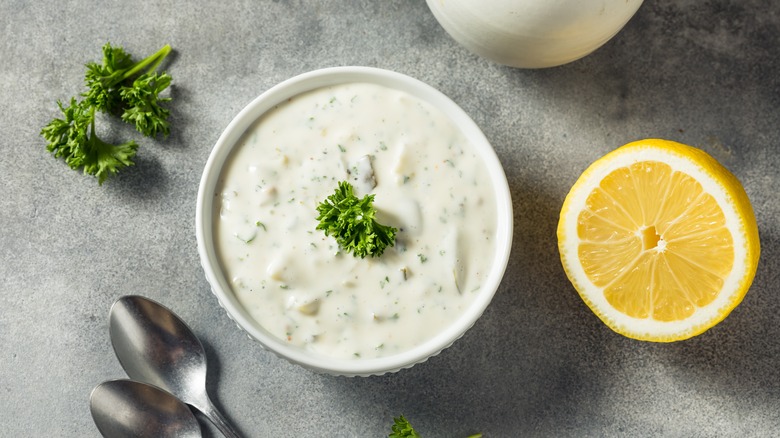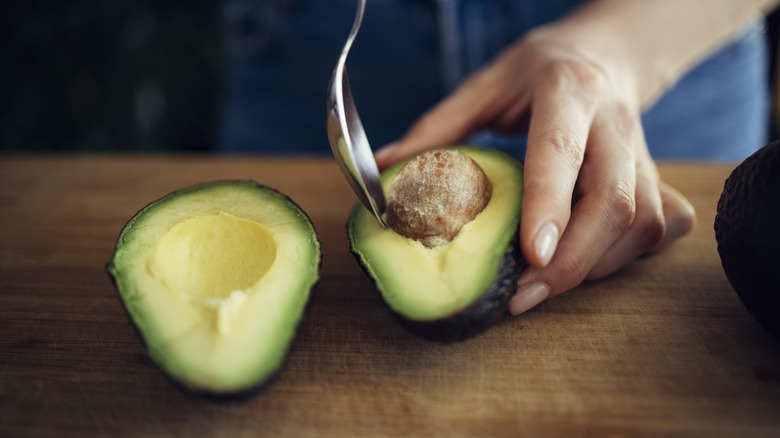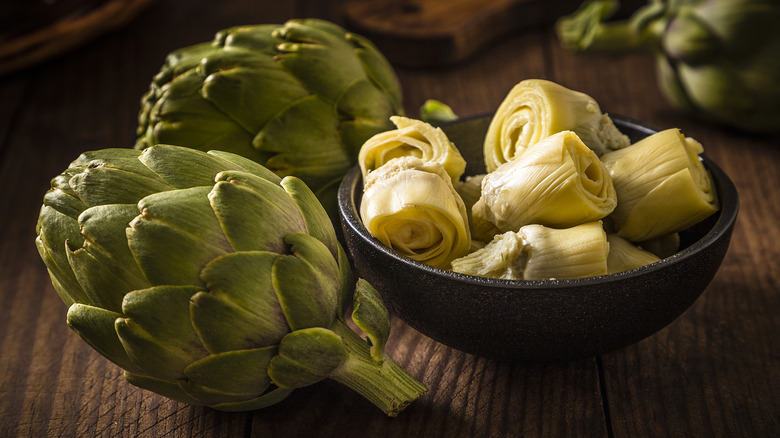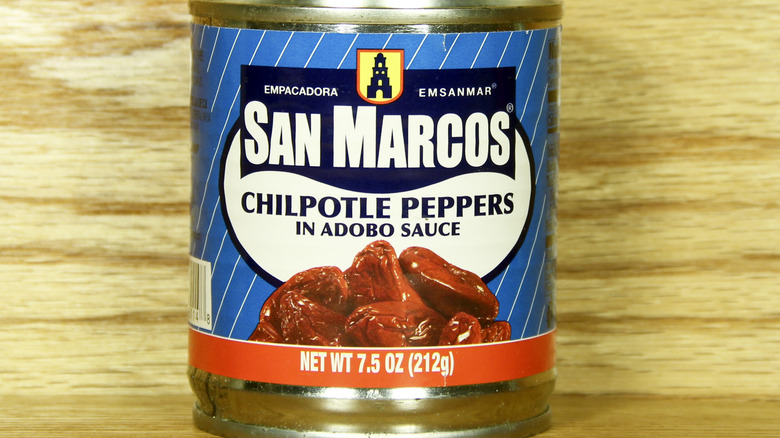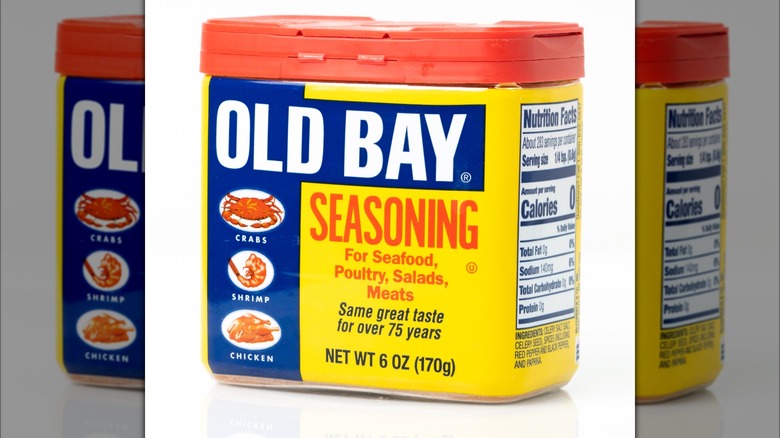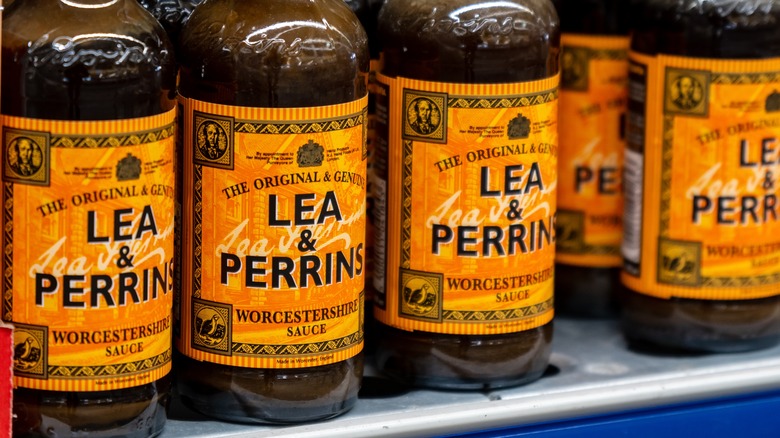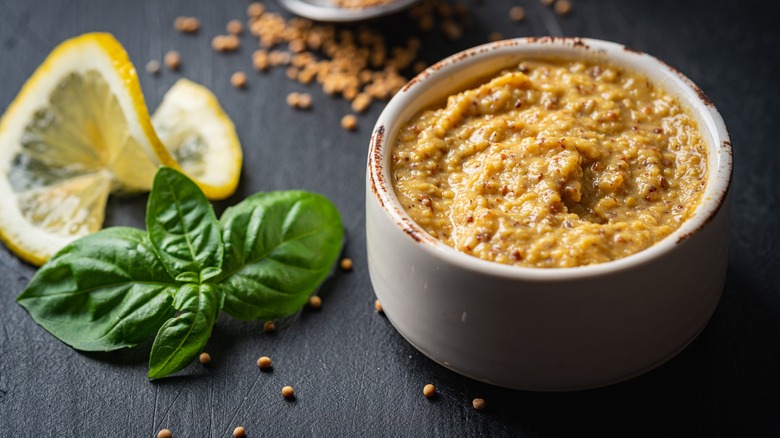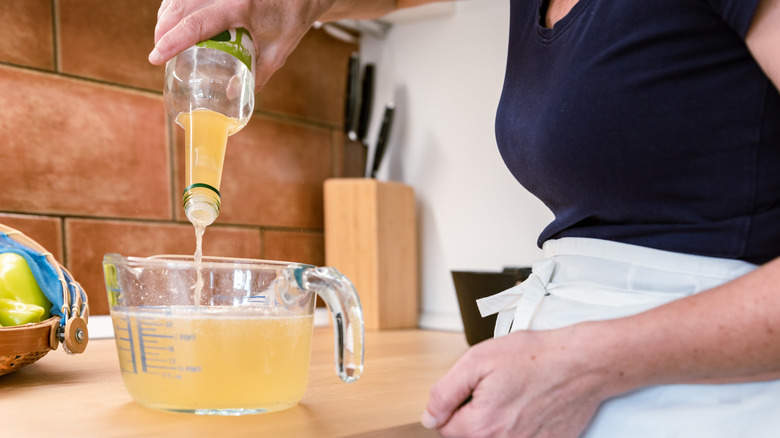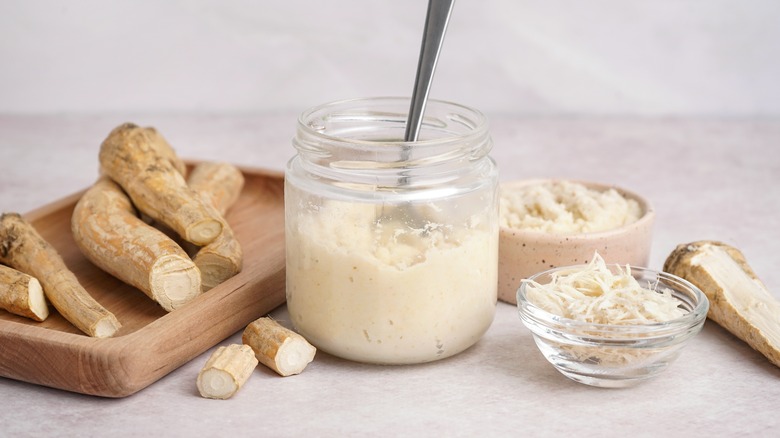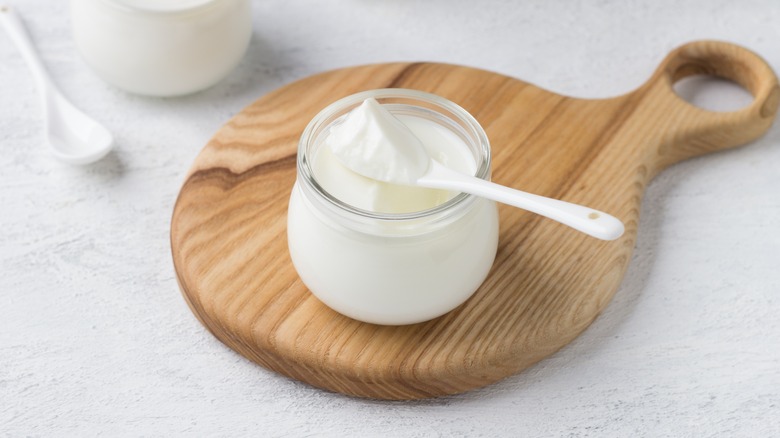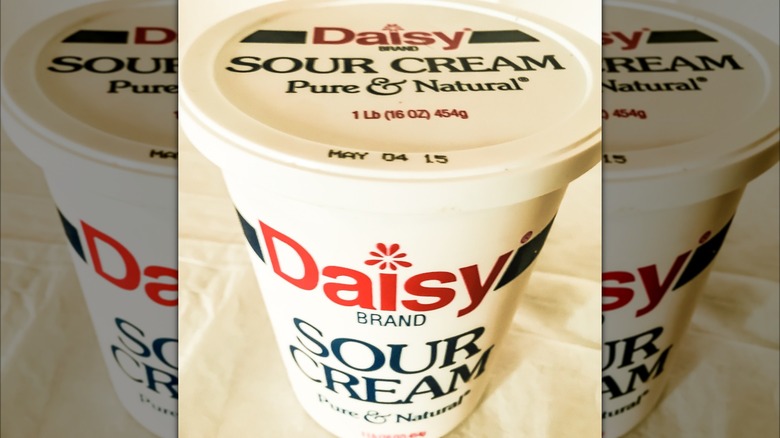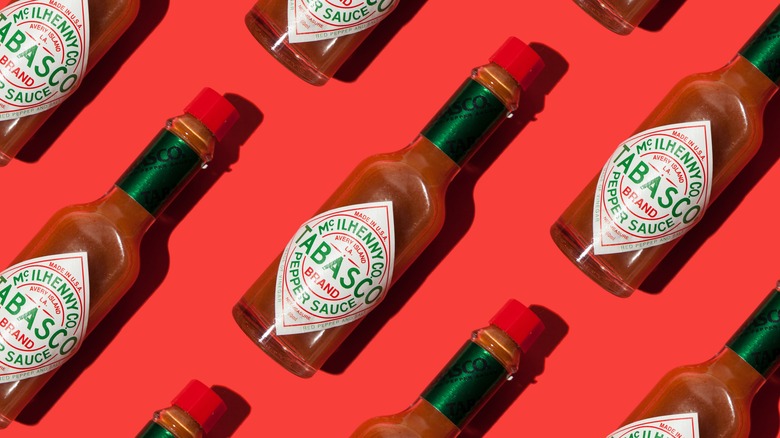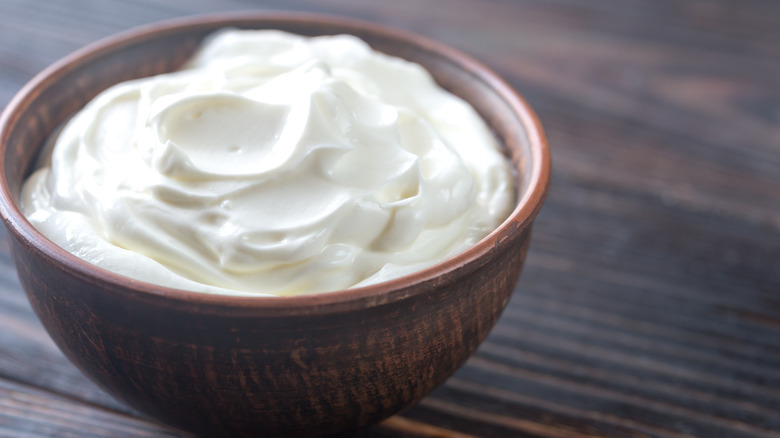12 Simple Ingredients That Will Seriously Upgrade Your Tartar Sauce
Tartar sauce is a relatively simple condiment. Creamy and mild, it pairs perfectly with the fattiness of fried fish. Dating back to at least 19th-century France, the sauce gets its name from the Tartars of eastern Europe; in French, "tartare" roughly translates to "rough," and this is indeed a "rough" sauce — not really smooth, and filled with roughly chopped ingredients.
A typical tartar sauce usually includes mayonnaise, pickles, sometimes onions or shallots, and, also sometimes, capers, along with an acid and some seasonings. However, just because tartar sauce is pretty much the same from recipe to recipe, from store-bought condiment bottle to store-bought condiment bottle, that doesn't mean you have to limit your tartar sauce-making skills to the same ol'-same ol'. With a few staple ingredients that you likely already have on hand, you can make your plain Jane tartar sauce stand out from the crowd, with an enhanced flavor and texture. Here some of our favorite simple ingredients that will seriously upgrade your tartar sauce.
Avocado
While, yes, avocado isn't the first ingredient you might think to pair with tartar sauce, the two are a pretty good match. Just think about how many fish tacos you've likely eaten that have included both avocado and tartar sauce. Why not just combine the two? Avocado is the perfect addition to a tartar sauce that leans a little more on the fresh, California-inspired side, and pairs equally nice with fish dishes that would fall into the same category. The avocado even gives the tartar sauce a springy green hue, and adds to the texture, thanks to the avocado's fat content.
However, using avocado in your tartar sauce isn't just a good idea for the extra flavor, texture, and visual appeal. You can also use avocado to turn your tartar sauce vegan, when you use it in your recipe in place of the traditional mayonnaise. Thanks to its fattiness, avocado is a popular substitute for mayonnaise in many vegan recipes, and it works just as well here.
Artichokes
Artichokes can add extra flavor and texture to your tartar sauce, and tartar sauce that includes artichokes makes an excellent accompaniment for salmon, no matter how you might be cooking it. Additionally, this is just a no-brainer match when you consider how, often, the sauces paired with grilled artichokes are mayonnaise-based and very similar to tartar sauce; likewise, many vegan recipes use artichoke in place of seafood, and then pair that "seafood" with — you guessed it — vegan tartar sauce.
You'll want to roughly chop your artichokes just like you might the pickles that you plan to use in your homemade tartar sauce; a food processor makes this process easiest. Then, combine your roughly chopped ingredients with the rest of your tartar sauce ingredients, such as the mayonnaise. It's an extremely simple upgrade. You don't even need to battle artichokes' difficult exteriors in order to cook a fresh artichoke. Jarred artichokes are the way to go; just make sure to drain them before adding them to your sauce.
Chipotles
If you find your tartar sauce is a little on the bland side, you might not get enough flavor from just adding the subtle fattiness of avocado, or relatively mild artichokes. So, kick things up a few notches, by adding chipotles to your tartar sauce. This addition makes for a slightly smoky-spicy tartar sauce that pairs well with seafood dishes of a similar acerbic slant, such as blackened fish.
Don't use chipotles all too often? Canned chipotle peppers in adobo sauce — which is what you'll want for this upgrade — are smoked, dried, and rehydrated jalapeño peppers in a sauce. The jalapeños retain a bit of spice, the smoking process provides some bitterness, and the sauce, tomato-based, is both sweet and acidic. You likely won't use an entire can of chipotle peppers in adobo for one batch of homemade tartar sauce, though. Instead, remove a few peppers from the sauce and finely chop them, before adding. If you're not accustomed to the flavor, you may want to additionally give the peppers a sample first, and then add them to taste. If you would prefer the flavor but without the noshable texture of
Old Bay and similar seasoning mixes
Don't want to go through the trouble of fishing out chipotle peppers out of the can and giving them a rough chop before adding them to your tartar sauce? While it hardly takes any time at all, if that's still more effort than you want to give, in order to imbue your tartar sauce with a spice-forward upgrade, simply reach for your spice rack and pull out a container of Old Bay, or whatever seasoning and spice mix that you have that's similar.
Old Bay is a go-to for leveling up your tartar sauce, as it already pairs so well with seafood. No Old Bay on hand? You can make a very similar copycat mix at home. While name-brand Old Bay contains nearly 20 ingredients, the primary spices are celery salt and paprika, so you can use a blend of these two to get a somewhat-close flavor profile, even if it's not an exact match.
Worcestershire sauce
If your go-to flavor is always going to be umami, not spicy, then consider adding a little Worcestershire sauce to your tartar sauce. Go a little easy on how much you add — too much extra liquid will thin out your tartar sauce, and you want it to remain perfectly dip-able and spreadable. Still, you need to add enough to get those umami notes.
Do keep in mind that just like traditional tartar sauce, Worcestershire sauce isn't vegan, nor is it vegetarian; traditional Worcestershire sauce contains anchovies. Other ingredients that help give this difficult-to-pronounce pantry staple its characteristic flavor? Beyond the fish, there's also vinegar, onions, garlic, molasses, and tamarind. Worcestershire sauce having vinegar qualities make this upgrade a particularly good pick if you love to eat your seafood with tartar sauce as well as a side of malt vinegar (in fact, some Worcestershire sauces specifically include malt vinegar).
Whole grain mustard
At its simplest, tartar sauce does not contain mustard. Instead, it simply relies on the basic combination of mayonnaise, pickles, sometimes onions or shallots, an acid, and some seasonings. Still, there are many recipes out there that do add mustard to the mix. Not regular yellow mustard, though. Instead, Dijon mustard is what you should add if you want to upgrade tartar sauce. As any condiment connoisseur would tell you, Dijon mustard is far bolder to traditional yellow mustard.
Apart from the more pungent flavor that Dijon mustard brings to tartar sauce, you can also use mustard to affect the texture. Adding whole grain mustard to your tartar sauce recipe gives you a pleasantly bitter flavor, but also an extra helping of texture. Similar to Dijon mustard, which often contains a low-acidity wine, whole grain mustard also often contains wine for a more complex flavor profile that increases heat and the slow mustard burn. The thick, seedy, and coarse whole grain mustard pairs well with the other roughly chopped ingredients in tartar sauce.
Champagne vinegar
Most tartar sauce recipes include an acidic element, such as lemon juice or malt vinegar. However, you can reach over malt vinegar and white vinegar for a tartar sauce upgrade with more sophistication: champagne vinegar.
Champagne vinegar is, as the name suggests, made from the same grapes that you would use to make wine, in this case, usually chardonnay or pinot noir. Compared to red wine vinegar and apple cider vinegar, champagne vinegar is sweeter. Compared to sherry vinegar, champagne vinegar is lighter and less harsh.
When shopping for Champagne vinegar (which isn't always easy, as this is more of a specialty ingredient), look at the label to ensure that the vinegar was made with chardonnay or pinot noir grapes (in some cases, pinot meunier, pinot gris, pinot blanc, petit meslier or arbane grapes may be used, though not as common). If the vinegar does not include one of these varieties on the label, it's likely not authentic.
Horseradish
Hot horseradish maybe doesn't get enough love when it comes to condiments, but adding just a few tablespoons of the ingredient to your tartar sauce can really give the sauce some zesty spice.
If you're not very familiar with horseradish or don't use it frequently, horseradish is basically a root, kind of like ginger, but in the same family as mustard. The horseradish you buy in the condiment aisle in the store is "prepared horseradish." As it also contains vinegar and salt, it is a pickled horseradish, and what you'll want to add to your tartar sauce. Prepared horseradish is more mild in spice than fresh. Similarly, buy horseradish sauce, though the mayo base means it's not terribly different from tartar sauce. A small 50-50 blend of the two sauces could make for a whole that's better than its parts alone.
If you want to get really adventurous, you can make your own prepared horseradish from scratch by processing the horseradish root on your own. Do note that this process is not for the faint of heart; raw horseradish can be overwhelmingly pungent, with an eye-watering smell that can absolutely take over your space.
Yogurt
If you're trying to cut down on the amount of saturated fats you consume or not a fan of mayo in general, you may avoid traditional tartar sauce due to its usual mayo base. However, you don't have to give up tartar sauce completely. You can simply swap your sauce's mayonnaise for yogurt to make a less-fatty, higher-protein take on tartar sauce. Do note that this swap will very slightly change the sauce's mouthfeel and texture, as it lowers the fat content, but if a lighter sauce is what you're after, this swap will achieve it.
Not just any yogurt will do for a good tartar sauce, though. Use Greek yogurt for the right texture and a nice level of creaminess. Then, just as you would when making tartar sauce normally, combine the Greek yogurt with your roughly chopped pickles and capers, and your acid of choice and seasonings. Making the switch from mayo to Greek yogurt comes with multiple health benefits, including more protein, fewer calories, healthier fats, and more vitamins and minerals.
Sour cream
Let's say that you've gone about making a tartar sauce recipe for the first time, and maybe you've used some of our suggested ingredients above to level up your tartar sauce beyond the ho-hum normal. However, maybe you used a little too much champagne vinegar, or maybe you ran out of Greek yogurt and didn't have quite enough to get the right tartar sauce consistency. Now, your sauce is all runny, and you fear that if you spread it on your fish sandwich, you'll end up with a soggy bun.
If this is what you're faced with, there's one ingredient you'll want to turn to, to thicken up your tartar sauce: sour cream. Sour cream can not only help you thicken your runny tartar sauce, but it will also add a nice little zing of flavor that will complement the tartar sauce's natural acidity. Don't add a lot all at once, though. Just add a few spoonfuls at a time, mixing and tasting as you go, until you reach your desired consistency. If you find the sour cream is a bit too acidic or tangy after this process, go lighter on any additional acidic ingredients, to taste.
Tabasco
In some instances, adding a little zip to your tartar sauce is as easy as grabbing some Tabasco and adding a few shakes to your sauce as you're giving it a final mix. Like some of the other recommended ingredient upgrades on this list, Tabasco contains peppers (in this case, red peppers), which offers a little bit of heat to blander tartar sauces, and then it also contains distilled vinegar, for that acidity that your tartar sauce naturally needs. The Tabasco's simplicity means you're not adding anything extra to your sauce that might clash with or overpower your other flavors.
So, grab your Tabasco and toss in a little. If you don't have Tabasco on hand, you can also try other favorite hot and similar sauces, such as buffalo sauce or sriracha; however, keep in mind that sauces like these have their own distinct flavor profiles, and are lacking some of the simplicity of Tabasco, so they'll affect your tartar sauce's flavor profile accordingly.
Crème fraîche
If there's anyone who knows how to make a good tartar sauce, it's likely Gordon Ramsay. The acclaimed chef has an entire chain of restaurants dedicated to fish and chips (aptly named Gordon Ramsay Fish & Chips) and what goes better with fish and chips than a lot of tartar sauce for dipping?
Gordon Ramsay adds one simple ingredient to his tartar sauce that makes all the difference: crème fraiche. Somewhat similar to sour cream and Greek yogurt, crème fraiche is a very creamy, high-fat cultured cream product, but it's not as sour as sour cream, and it's thicker than Mexican crema.
Ramsay doesn't replace all of the mayonnaise in his tartar sauce with crème fraiche, though. He uses just a few tablespoons of crème fraiche, alongside a third of a cup mayonnaise, and then adds the requisite pickles, shallots, and lemon juice. The end result is a creamier, velvety-er tartar sauce that's still pretty close to the classic original.
